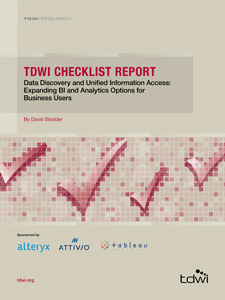
TDWI Checklist Report // Data Discovery and Unified Information Access
August 7, 2011
Demand for business intelligence (BI) and analytics continues to be strong, but expectations are changing. Emerging expectations are for easy-to-use, self-service, and graphical environments that let users work interactively with and explore different types of data. Users want rapid application development and deployment capabilities for meeting changing requirements. They want to access and analyze not only structured data, but also unstructured content.
Organizations struggle to meet such elevated expectations with most existing BI systems. This has created a prime opportunity for data discovery tools, which offer a fresh approach to data access, reporting, and analytics. Equally interesting are unified information access (UIA) tools, which focus on integrating BI, search, and analytics for both structured and unstructured data.
This Checklist Report focuses on helping organizations understand how data discovery and UIA tools address new requirements for data access, reporting, and analytics, particularly for nontechnical users in lines of business and operations. The Checklist examines how these new tools can help organizations add breadth, depth, speed, and flexibility to users’ pursuit of information insight from both structured data and unstructured content. It closes with guidance for developing best practices and ensuring that IT data governance and provisioning concerns are addressed while meeting expectations for greater user self-service and flexibility.